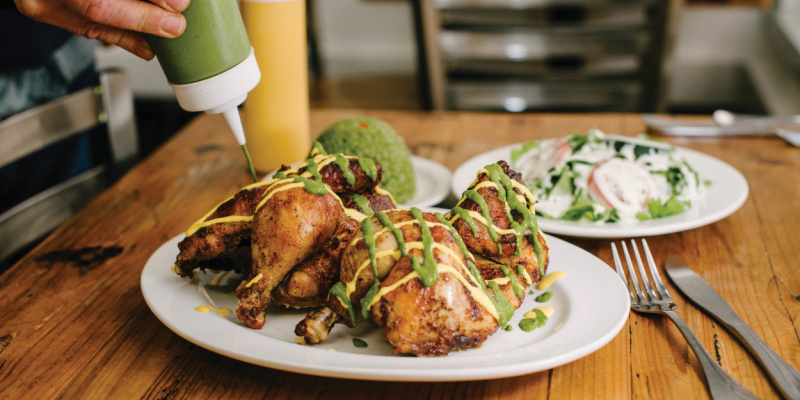By Hannah Wente | Photography by Hillary Schave (pictured: Estacion Inka)
Madison is a city full of transplants. Whether you came here for college, a job or another reason — it’s a colorful city filled with people from all over the world. On a daily basis, you’ll likely hear a variety of languages spoken during a stop in your favorite coffee spot or dropping your kids off at school. And lucky for us, our culinary options reflect this melting pot of global influences.
Our international dining scene has tons of restaurants, many family- owned, that are tucked in all parts of the city — from the Williamson Street neighborhood to the campus area to the far west side. Trying these eateries can unearth a new world of flavor, ingredients and cooking styles — inspired by the home cooking that many of these restaurateurs grew up eating.
Now, it’s time to drive in any direction and dig in.
Eastern Asia
East Asian cuisine includes foods and flavors from China, Japan, orea and Taiwan.
Wendy Kuo moved from Taiwan to New York when she was four years old. Her husband, Mike Ding, a UW-Madison graduate, and his business partner opened Umami on Williamson Street in 2011 while she was working full-time for a social media company in Madison. The casual-cool eatery brought the now-flourishing ramen trend to Madison. Umami is known for steamed Taiwanese mantou buns, often described as fluffy clouds because they’re soft and white, filled with pork, beef or tofu.
In 2015, Kuo and Ding (along with restaurant group Food Fight and Kuo’s brother) opened Tavernakaya, their second restaurant, on the Capitol Square. (Kuo and Ding are now the only owners.) Tavernakaya is a hybrid of a Wisconsin tavern and an izakaya, a Japanese word for informal bars that serve drinks and snacks. They modeled the atmosphere after the izakayas they love in New York, Japan and Los Angeles. Initially, they served Japanese fare in a Spanish tapas style, with staples like meat skewers and savory Okonomiyaki omelets.
However, Kuo notes, “we [have] evolved our menu to meet customer demand for more entrees and sushi rolls.”
Today, you’ll find a mix of Wisconsin staples like tempura- fried cheese curds, a full sushi menu and of course, ramen. Order the three-cup chicken, a Taiwanese dish that Wendy grew up eating. Also find menu items from Umami at Tavernakaya throughout the winter.
***
Rachel Kim had two cooking teachers — her mom and an older mentor in Korea. She now channels both of them, along with her hometown of Busan, to cook up traditional Korean fare at K-Peppers in Middleton.
“We are very authentic,” says Rachel. “I learned cooking from my mom — she’s 93 years old. I couldn’t find traditional foods here. [At the time] there were only two Korean restaurants — [and] honestly they were not that good. The food was too bland.” Rachel moved here from Korea in 2008. She and her husband, Eric Kim, opened K-Peppers in 2009 to bring flavor to the Korean restaurant scene. They started out sourcing roots and other authentic ingredients from Korean grocery stores in Chicago, but switched to vegetables bought from local stores in Wisconsin — kale, Brussels sprouts and carrots — to please local palates. Their bulgogi beef bibimbap is the most popular dish — rice on the bottom, vegetables and meat on top — covered in egg and sizzling hot, with sauce on the side.
Southern Asia
South Asian cuisine includes Nepal, Thailand, Laos, Vietnam and Indonesia.
Julie Adriansjach’s husband and in-laws started cooking for Indonesian students at UW-Madison in the 1990s. You can still find the three of them cooking together at Bandung restaurant on Williamson Street.
“No recipes are written down, it’s all by memory,” says Julie. “My husband keeps a few of the dishes traditional, including the opor ayam and the gulai kambing. He also creates fusion dishes like bopo tempeh and bopo chicken with ginger, cilantro and jalapeño sauce.”
The opor ayam is chicken breast with potato, bamboo shoots and lemongrass in a coconut milk broth. Gulai kambing is a rich and flavorful lamb curry. Their most popular vegetarian dish is sambal goreng tempeh, made with green beans and mung bean noodles. You’ll even find pad thai here, an homage to the Thai restaurant that used to grace this spot.
Their most popular dish is daging rendang, likened to American pot roast, which is made differently on each Indonesian island. On their home island of Java, it’s made with beef that’s tenderized by simmering it in coconut milk with lemongrass, potatoes and various Indonesian spices. Another Indonesian staple is kecap manis, a thick, sweet soy sauce made with Indonesian palm sugar that can be found in many of Bandung’s dishes.
Haven’t tried Indonesian cuisine before? Julie says, “Don’t be scared. Don’t be intimidated. There’s something for everybody — Southeastern Asian food is not all spicy.” You can even find their homemade tempeh at Willy Street Co-op East and West, as well as in dishes at Green Owl, Monty’s Blue Plate and Argus.
***
Tammy Phommachanh started cooking at a young age, and it was something that came naturally to her. She came to the U.S. as a Vietnam War refugee when she was just 17 years old. Phommachanh spent the past two decades working at, then owning, a nail salon in Rockford. It was her son, Sam Phothiboupha, who recognized his mom’s talent for cooking and encouraged her to open her own eatery in Madison.
The duo learned sauces and bases from family members in Orlando before opening Hot-n-Spicy in 2019 in Viet Hoa Market on Monona Drive. Although Phommachanh is Laotian, they wanted to serve a variety of Southeast Asian favorites, including crab rangoon (Chinese-American), pad thai (Thailand) and pho (Vietnamese). They use traditional Laotian flavors and ingredients that masterfully transform these classic dishes into something new.
“We are Lao,” says Phothiboupha, “so the flavors come from Laotian groups: bitter, sour, savory and spicy. In our home country, spicy is a sport almost!”
Hence the name of the restaurant: “Hot-n-Spicy.” When ordering, you can select a spice level from zero to four.
Pho, a noodle soup with broth, meatballs and scallions, comes with a container packed with the works: fresh mung beans, cilantro, Thai basil, jalapeños and rice noodles. The Third Wheel appetizer plate overflows with three each of gorgeous shrimp-filled spring rolls, egg rolls, crab rangoon, meatballs and chicken satay.
“We make food that we like to eat” says Phothiboupha. “We take that extra step in everything we make.”
***
Located on East Johnson Street, Little Tibet is known for their momos – bite-sized, twisted dumplings that are filled with meat
or vegetables and steamed. With several varieties, you’ll want to sample them all. Try the chicken momos served in red jhol sauce — a warming blend of spices, cumin and fenugreek that pairs nicely with the starchy dumplings.
Nepalese cuisine is influenced by Tibet to the north and India to the south. In the past, Little Tibet has served dishes in an Indian thali style, on a platter in individual metal tins. Mutton is also very popular in Tibet and often put in stews with potatoes. Today, Little Tibet’s most popular dish is the Tibetan lamb curry paired with — you guessed it — trays of momos.
Central and South America
Marleni and Silas Valle share their El Salvadoran culture and street food with Finca Coffee customers nearly every day. Each pupusa, quesadilla, taco and burrito is handmade at this South Madison locale, which opened in 2019. Silas says their sweet Salvadoran quesadilla is the original recipe from Marleni’s mom.
Beyond the quesadilla though, Marleni’s mom’s recipes are used throughout the menu so they can continue to share the homemade goodness. One of these is pupusas, which Marleni’s mom made for her growing up — and it’s also the national dish of El Salvador. The specialty consists of a thick flatbread filled with pork and cheese or cheese and beans, and they’re eaten for breakfast, lunch or dinner. Their most popular menu item is the breakfast or lunch burrito, adapted from the Mexican version. Their take is made using thick handmade corn tortillas, marinated meat or vegetables and refried beans.
They also serve single-origin coffee, directly sourced from farmers they know in El Salvador — fitting for a place called “finca,” which means “farm” or “ranch” in Spanish. ***
In South America, Peru is known for its “meat and potatoes” cuisine — filling portions of the aforementioned items, served with a relish of red onions, peppers, lime juice and cilantro. But you don’t have to take a flight to experience Peruvian cuisine — there are two options in the Madison area — Estacion Inka on University Avenue and Mishqui on Monona Drive. Both offer classic rotisserie chicken and pork chicharron served with sides like cilantro rice, black beans and sweet plantains.
Not hungry for a full meal? Grab a sweet treat from Mishqui’s pastry case or get an order of empanadas or fried plantains to share. Wash it all down with Peruvian Chicha Morada, a purple corn, fruit and spice drink — it tastes like a melted popsicle on a hot day.
***
At La Taguara, you can try arepas, which are one of the most popular foods in Venezuela. (If you haven’t tried one, you’re missing out.) The word arepa comes from the traditional word for maize — it’s a corncake made from maize meal (cornmeal) that’s crisp on the outside and fluffy on the inside. In Venezuela, they’re stuffed with meat and/ or cheese. At La Taguara, you can get arepas filled with beef, plantains or pork. Add Venezuelan guasaca on the side — it’s a lighter guacamole made with green pepper, parsley and olive oil.
What’s wonderful about Venezuelan cuisine is that it ties in flavors and cooking methods from Spain, West Africa and Indigenous cultures. Tribes in what is now Venezuela and Colombia have been making arepas for centuries. Reflective of this, La Taguara also serves empanadas, which are savory turnovers, and traditional Cubano sandwiches.
Mediterranean
This cuisine originates from the basin of the Mediterranean Sea — encompassing Italy, France, Greece, Egypt, Spain aAnd the former Ottoman Empire.
At Mediterranean Café, you’re greeted by baskets of freshly-made pita and handmade hummus. Here, the two most popular entrees are the falafel plate and the shawarma plate. The former is two balls made with grains and herbs, and the latter is made with lamb or beef paired with tahini or chicken with yogurt sauce. It’s served with rice, salad, hummus and pita bread. End the meal with a sweet treat by ordering the pistachio baklava.
***
It’s impossible to go hungry at Banzo on Sherman Avenue. Their unique menu is fun for kids and adults alike. First decide if you want a sandwich (served on a pita), platter (served with rice, salad and hummus) salad (with feta, chickpeas and olives) or a
hummus plate as a base. Next choose your main filling such as beef kebab, slow-roasted chicken or classic or sweet potato falafel. I recommend the F-bomb, which is falafel and chicken. Then pick your sides and any extras — like the lentil soup or baklava.
***
Mary Ann and Marc Bellazzini grew up in nearby neighborhoods in Chicago. Both of their families are originally from Italy — and many still live there today. The Bellazzinis own Campo di Bella, a farm-to- table restaurant and winery on 20 acres in Mount Horeb. They serve three-course meals on Friday nights and five-course meals on Saturday nights year-round. All menu ingredients are either grown on-site or sourced locally, says Mary Ann. My favorite meal is the pesto lasagna, served with a salad and foccacia, ending with homemade amaretto biscotti.




